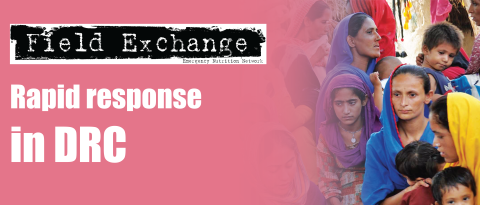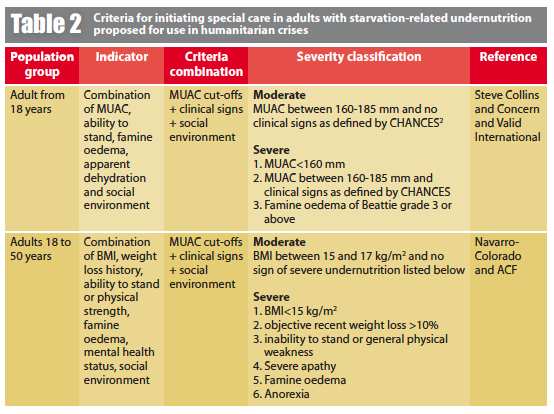Anthropometric cut-off points for older children and adolescents in Syria
By Paluku Bahwere
Paluku Bahwere is a paediatrician with over 25 years of experience in operational research and programming in the fields of public health, paediatrics, nutrition and HIV/AIDS. He joined Valid International in 2003 and since then, has provided technical support to Ministries of Health in Malawi, Zambia, Zimbabwe and Mali, and supported a number of international NGOs. In 2006, he became Valid International’s Research Focal Person and has led the design, implementation and analysis for several large cluster randomised trials.
The author acknowledges UNICEF Syria for initiating the research and for their valuable input and contributions. Thanks also to Sarah Jones and Kate Sadler, Valid International, for their help in coordinating this article for Field Exchange.
We are delighted to include this article on innovation in assessment of acute malnutrition in older children, adolescents and adults in Syria, a known gap area for many years. The process and considerations in arriving at the proposed criteria are transparent; preliminary discussions are underway for a follow-up study to test the criteria. This initiative should undoubtedly inform global guidance, not only in terms of content but approach (Eds).
Location: Syria
What we know: There is a lack of guidance on assessment and treatment of acute malnutrition where population access is severely hampered, staff capacity is limited and children over five years are affected. This is currently the situation in Syria.
What this article adds: Valid International, in collaboration with UNICEF Syria, has developed contextualised mid-upper arm circumference (MUAC) cut-off points for older children, adolescents and adults to meet critical assessment needs in Syria. This is part of a larger package of work that includes development of contextualised treatment protocols. The cut-offs are based on extensive review of relevant published and grey literature; primary data were lacking. Key considerations were simplicity (hence the selection of MUAC) and the necessity for early identification in a conflict context where individuals need to remain mobile and independent; given this, functional criteria are also proposed. The cut-offs will be applied to a pilot of a nutritional surveillance system for hard-to-access and inaccessible areas targeted by UNICEF in Syria. Discussions are underway about a short follow-up study to determine the diagnostic performance of proposed cut-offs.
Introduction and context
 As part of a package of work, Valid International (Valid) has been undertaking for UNICEF Syria since mid-20161>, Valid has developed contextualised mid-upper arm circumference (MUAC) cut-off points for older children and adolescents in areas where access issues prevent direct assessment of height-related indices. These were developed to inform continuous data collection and analysis and intervention design. The intention was to draw on primary data to determine appropriate cuts-offs for these age groups in besieged areas in Syria. However, due to the paucity of survey and other data available, primary analysis was not possible. Instead, we undertook an extensive review of published and grey literature on MUAC distribution in children, adolescents and pregnant and lactating mothers from the Middle East region. This article shares the outcome of that review and presents the proposed cut-offs. It is worth noting that, as they stand, these cut-offs are a ‘best estimate’ based on accessible data and material and would ideally be verified as appropriate through primary research; this is being explored (see ‘Next steps’ below).
As part of a package of work, Valid International (Valid) has been undertaking for UNICEF Syria since mid-20161>, Valid has developed contextualised mid-upper arm circumference (MUAC) cut-off points for older children and adolescents in areas where access issues prevent direct assessment of height-related indices. These were developed to inform continuous data collection and analysis and intervention design. The intention was to draw on primary data to determine appropriate cuts-offs for these age groups in besieged areas in Syria. However, due to the paucity of survey and other data available, primary analysis was not possible. Instead, we undertook an extensive review of published and grey literature on MUAC distribution in children, adolescents and pregnant and lactating mothers from the Middle East region. This article shares the outcome of that review and presents the proposed cut-offs. It is worth noting that, as they stand, these cut-offs are a ‘best estimate’ based on accessible data and material and would ideally be verified as appropriate through primary research; this is being explored (see ‘Next steps’ below).
Background
The conflict in Syria has devastated the country and its people. An estimated 11 million Syrians are no longer living in their homes and are either internally displaced persons (IDPs) (6.5m) or refugees in neighbouring countries (4.1m). At least 8.7 million people are unable to meet their food needs. Households in hard-to-reach and besieged areas have provoked the highest concern, since they are the most in danger and the most food-insecure (HNO, 2016). It is estimated that 2.5 million people out of the 4.5 million people living in these areas are severely food insecure. The prevalence of acute malnutrition (AM) was 7.2% in children aged 6-59 months in 2014 (Rapid Nutrition Assessment in IDPs, 2014). Ongoing fighting, population movements and insecurity pose challenges of access and provision of adequate nutrition services to women and children in some areas (Humanitarian Response Plan, 2016). As the situation in the besieged areas continues to deteriorate, with limited nutrition information available, UNICEF has made additional efforts to gather both formal and informal data on the nutrition situation of children through MUAC screening in 2016.
Justification
Due to access challenges in hard-to-reach and besieged areas, AM has been reported in multiple age groups that include children under five years, older children aged 5-10 years, adolescents and even adults. Several challenges are faced in performing sound measurement in identifying malnutrition among the above mentioned age groups, including:
- Absence of valid MUAC cut-off points for children over five years, adolescents and adults to classify their nutritional status; currently recommended definitions of AM require height measurement, which is hard to obtain in these areas;
- Lack of contextualised treatment protocols to address malnutrition among children over five years, adolescents and adults living in these areas; and
- Difficulties in providing capacity-building support to the limited numbers of health workers inside these areas.
Developing rapid nutrition-needs assessment tools, contextualised treatment protocols and a monitoring mechanism for AM in older children, adolescents and adults living in these areas will greatly contribute to efforts to minimise the impact of AM. This research was commissioned as part of a larger piece of work aiming to address the gaps listed above. This article describes the approach and outcome in defining contextualised, MUAC-based cut-offs that can be used to define and help in the early detection and treatment of AM among all age groups.
Review findings
Definition of undernutrition: current consensus
Undernutrition can be defined as a state of nutrition in which an imbalance of energy, protein and other nutrients causes measurable negative effects on body and tissue shape, size and composition, resulting in the alteration of body functions and adverse clinical outcomes. Undernutrition is an umbrella term for various nutrition-related (see Figure 1) (Cederholm et al, 2015). For the present work, the focus was on starvation-related underweight. Sarcopenia, used to describe loss of muscle mass and strength of any origin, was also used during the literature search (Muscaritoli et al, 2010).
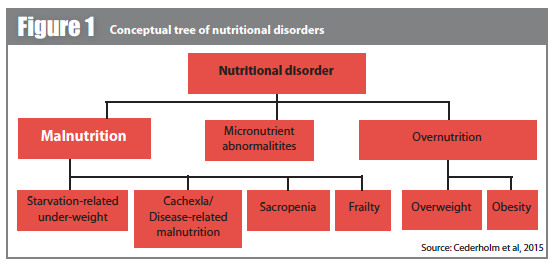
A series of meetings have taken place to reach consensus on defining malnutrition in older children, adolescents and adults (Table 1) (Cederholm et al, 2015; Muscaritoli et al 2010; Becker et al, 2015; Malone & Hamilton, 2013). While there is consensus that the initiation of special care for undernutrition is at the onset of body function impairment, the different committees did not include this criterion, probably because of the scarcity of published data linking body function and proposed anthropometric indicators, especially for starvation-related undernutrition.
The only study conducted in a non-humanitarian context surveyed adolescents with anorexia nervosa and concluded that MUAC is better than Body Mass Index (BMI) in predicting body function and proposed cut-offs of 200 mm for initiation of special nutrition care (Martin et al, 2009). The other studies conducted during humanitarian crises evaluated risk of death based on both BMI and MUAC (Collins, 1993; Collins, 1995; Collins, 1996; Collins et al 2000; Collins & Myatt 2000; Collins et al, 1998; Navarro-Colorado 2000; Navarro-Colorado 2005). These studies yielded a different conclusion regarding the anthropometric indicator of choice, as illustrated by the derived guidelines presented in Table 2.
However, these may be too restrictive because they aim at minimising admissions in therapeutic feeding centres (hospitals) and have not yet fully integrated the benefit of community-based management. They are also aimed at a population that is not at risk of having to move in order to avoid bombing or location attacks by armed groups. In this context, it is very important for individuals to remain mobile and to be able to walk independently, which suggests the need for earlier intervention.

Current practices for initiation of therapeutic feeding: Selected examples
Criteria used in selected developing countries for diagnosing severe undernutrition and initiating special nutrition interventions were reviewed. We found variability of both admission and discharge criteria. Efforts were made to retrieve the guidelines of countries closer to Syria or those in the same WHO geographic zone. See Table 3.
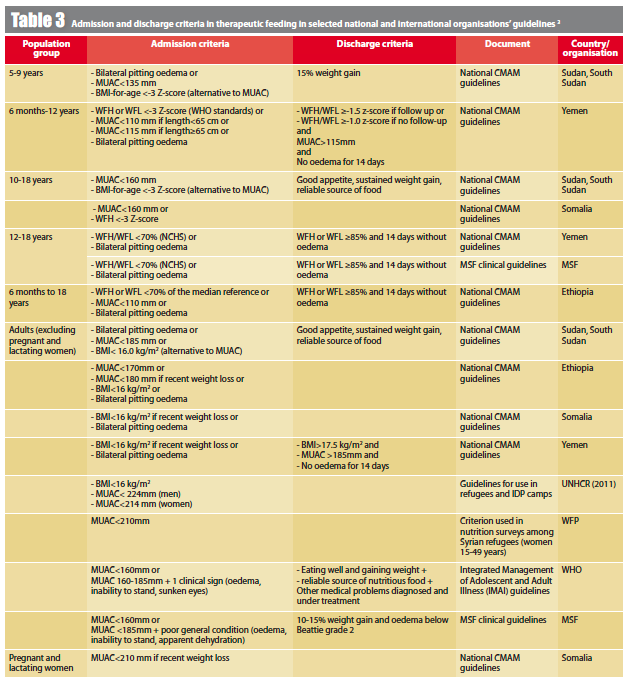
Definition of context-specific, MUAC cut-offs
Rationale for using MUAC
In 2009, the World Health Organization (WHO) and UNICEF endorsed the use of mid-upper arm circumference (MUAC) as an independent criterion for screening and assessing acute malnutrition among children aged 6-60 months and published updated guidelines recommending a MUAC cut-off of <11.5cm (WHO, 2013; WHO & UNICEF, 2009). The use of MUAC offers the advantages of a simple and relatively inexpensive measure (requires minimal equipment) that can be carried out in both community and facility-based settings, with acceptable accuracy and precision even by minimally trained frontline service providers (no calculations needed). The use of MUAC in children under five programming has improved the ability of CMAM programmes to increase coverage and recovery rates of treatment of severe acute malnutrition (SAM) in various contexts, including complex humanitarian crises and stable developmental situation (Collins, Dent et al, 2006; Collins, Sadler et al, 2006). A recent study has shown that in a group of children aged from 3 to 14 years, MUAC correlates very well with body fat mass (BFM), whether they were healthy or suffering from Cystic Fibrosis (Chomtho, 2006). Similar findings have been observed in adolescents and adults, including pregnant women (Tang et al, 2013)
Many national guidelines for the management of acute malnutrition include MUAC cut-offs for admission and discharge of older children, adolescents and pregnant and lactating mothers. However, these criteria have rarely been used and have not yet been validated to confirm performance in selecting those in need of specialised nutrition intervention(s). In addition, these criteria vary from country to country, making it difficult to confirm suitability for the current Syrian context.
Methods
This work is based on a literature review and analysis of data from different sources. Table 4 summarises the information reviewed in order to complete the task of determining contextually suitable cut-offs for Syria confidently.
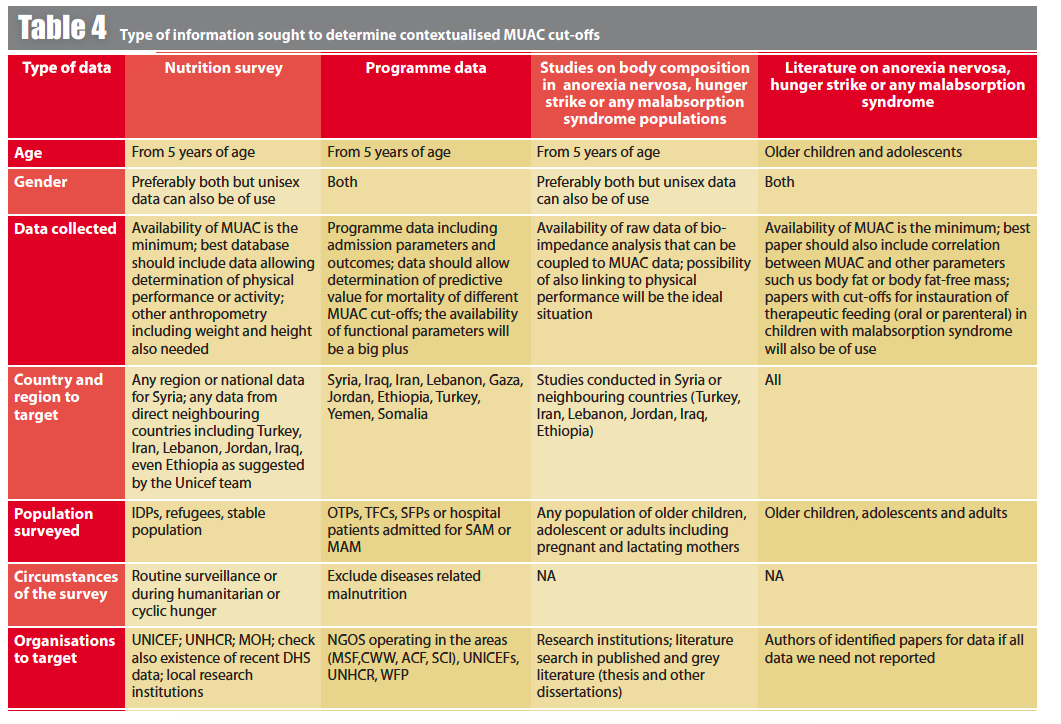
The objective of the literature review was to identify studies that describe correlation between MUAC measurement and body functions, including physical performance, cognitive functions and survival of the age groups of interest. Pubmed and google scholar were used for the literature search. References listed in the papers selected from the literature review were also used.
The objective for analysis of programme data was to help identify cut-offs currently used, the predictive value of MUAC for different outcomes and the diagnostics value of different MUAC cut-offs for identifying children with impaired body functions. We also aimed to get data that could enable us to determine correlation between MUAC and BFM and MUAC and Body Free Fat Mass (BFFM). Such a database would help to identify cut-offs corresponding to percentage of BFM and BFFM reduction. Finally, we aimed to obtain nutrition survey datasets from Syria or neighbouring countries to determine distribution of MUAC for the age groups of interest and AM based on the percentiles.
Outcome of the information search
The information search was successful in identifying published data that supported the determination of cut-offs based on the distribution of MUAC in the target age groups, but was unsuccessful in acquiring data that allowed us to confirm the capacity of these cut-offs to select those with functional impairment or risk of negative outcomes. The key documents used for the determination of the cut-offs were:
- Cross-sectional reference values for mid-upper arm circumference, triceps skinfold thickness and arm fat area of Turkish children and adolescents (Ozturk et al, 2009).
- Arm Anthropometry Indices in Turkish Children and Adolescents: Changes Over a Three-Year Period (Cicek et al, 2014).
- New reference values for mid upper arm circumference of Shiraz (Iran) primary school children (Ayatollahi & Shayan, 2008).
- Nutrition assessment – Syrian refugees in Lebanon (2015).
- Syrian women SMART survey database.
- Compilation of data of school-age children admitted in various Valid International programmes.
- Compilation of data of chronically sick adults enrolled in various Valid International research programmes.
- Guidelines for an integrated approach to the nutritional care of HIV-infected children- 6 months-14 years (WHO, 2009 [2]).
- The assessment and treatment of severe adult malnutrition (Collins, 2001).
Proposed cut-offs
Severe acute malnutrition
The principles and assumptions considered for defining the cut-offs are:
- 5-9 year old and 10-14 year old children:
- Severe acute malnutrition is confirmed when there is evidence of recent weight loss of over 10% of the usual weight.
- Distribution of MUAC is similar to that of the Third National Health and Nutrition Examination Survey (NHANES-III)2 children, although Syrian children are likely to have slightly higher BFM for the same anthropometry.3
- Early loss of body mass is mainly fat.
- Treatment has to start when children are still ambulatory and at low risk of superimposed complications.
- In the absence of data supporting determination of body-function based cut-offs and the absence of MUAC reference data for Syrian children, MUAC references for Turkish and Iranian children have been used.
- Third percentile value for the lowest age of age category has been used to define admission cut-offs.
- The value representing the 25th percentile of the middle of the age category is used for discharge cut-offs.
- The limited existing evidence from African programmes shows that children in these age groups (admitted using weight-for-height Z-score<-3 criterion) had MUAC at admission up to 172 mm for the age group 5-9 years and up to 182mm for those in the age group 10-14 years. These children were responding well to the treatment.
- 15-17 year old adolescents:
- Treatment aims to both improve nutritional status of women and prevent negative adverse outcomes of eventual pregnancy, including low birth weight.
- Severe acute malnutrition is confirmed when there is evidence of recent weight loss of over 10% of the usual weight.
- Distribution of MUAC is similar to that of NHANES-III children, although Syrian children are likely to have slightly higher BFM for the same anthropometry.
- Treatment has to start when the adolescents are still ambulatory and at low risk of superimposed complications.
- Studies have shown that most adolescents with MUAC <200mm due to semi-starvation (anorexia nervosa) remain active and clinically well, but that those with MUAC < 200 mm often need special medical/nutrition attention (Martin et al, 2009).
- Studies in anorexia nervosa have shown that, with appropriate treatment, nutrition recovery (MUAC ≥ 230mm) occurs within three months.
- ≥18 year olds
- Severe acute malnutrition is confirmed when there is evidence of recent weight loss of over 10% of the usual weight.
- Studies have shown that risk of low birth weight is increased in children whose mothers had MUAC<220mm during pregnancy.
- For Syrian refugees and internally displaced persons, humanitarian agencies use <210 mm as the cut-off for severe wasting and <230mm for wasting to assess the nutrition status of woman of reproductive age.
- Treatment has to start before severe impairment of physical performance, meaning when the women are still ambulatory and at low risk of superimposed complications.
Based on the above listed principles or assumptions, the proposed cut-offs are as indicated in Table 5.
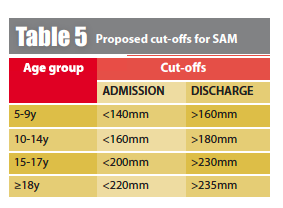
Moderate acute malnutrition
The principles and assumptions considered for defining the cut-offs are:
- 5-9 and 10-14 year-olds:
- Children with MUAC below 5th percentile in the normal distribution of MUAC are likely to have weight loss well above the 10% mark and be at risk of SAM.
- Any mild acute infection can lead to deterioration to SAM.
- 15-17 year old adolescents:
- Children with MUAC< percentile 5 cut-offs are likely to have weight loss well above the 10% mark and be at risk of SAM.
- Use of percentile 5 will not result in an excessive increase of eligible adolescents. A maximum of 5% will be eligible.
- For Syrian refugees and internally displaced persons, humanitarian agencies are using <210 mm as the cut-off for severe wasting and <230mm for wasting to assess the nutrition status of woman of reproductive age, including adolescents from 15 years of age.
- ≥18 year olds:
- Studies have shown that risk of low birth weight is increased in children whose mothers had MUAC<220mm during pregnancy.
- For Syrian refugees and internally displaced persons, humanitarian agencies are using <210 mm as cut-off for severe wasting and <230mm for wasting for assessing the nutrition status of women of reproductive age.
Based on the principles or assumptions above, the proposed cut-offs for MAM are as indicated in Table 6 below.
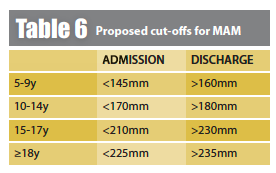
Body functions and acute malnutrition
Deterioration of nutrition status is also associated with cognitive and physical impairments and these impairments manifest before individuals qualify for nutrition intervention based on anthropometric criteria (Genton et al, 2005). Early initiation of treatment of SAM has been key in the success of CMAM by reducing the proportion of children under five years old who start treatment with superimposed medical complications (Collins, Dent et al, 2006). A similar approach should be taken for the other age groups to maximise treatment uptake and success. Several parameters can be used to assess cognitive and physical function for determination of eligibility for nutrition intervention and monitoring of the response to the intervention (Ozturk et al, 2009). These include handgrip strength (HGS), ability to stand, ability to walk independently, the timed up and go (TUG) test, six-minute walk test, and ability to perform activities of daily living (ADL) independently. However, in war-ravaged and besieged areas there is a need to minimise assessment time and consequently only simple and time-saving indicators should be used. The proposed indicators to be used for confirming starvation impact on body function are:
- General attitude and alertness
- Lethargy/fatigue.
- Somnolence (strong desire to sleep).
- Extreme lethargy and inertia.
- Muscle strength
- Ability to sit and stand up independently.
- Ability to move independently.
- Walking speed.
- Others
- Appetite (abnormal if reduced).
- Pulse rate (abnormal if <40bpm or >60 bpm at rest).
- Body temperature (abnormal if hypothermia as defined locally-<35.5°C).
- Famine oedema.
Based on these signs, a decision to admit or not can be made. Inpatient referral should also be made for those who fulfil either or both of the criteria below:
- Bedridden (not ambulatory and unable to complete activities of daily living independently).
- Medical condition requiring hospital management as per IMAI guidelines (WHO, 2011).
Next steps
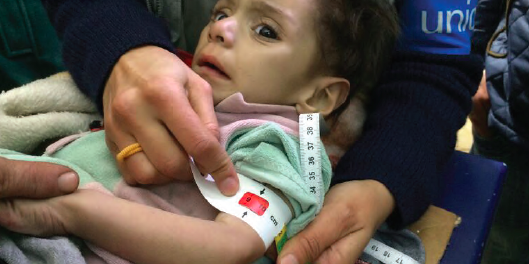 The MUAC cut-offs proposed here will now be applied to a pilot of a nutritional surveillance system for hard-to-access and inaccessible areas targeted by UNICEF in Syria. However, these cut-offs are based on secondary data describing the distribution of MUAC in relevant populations. Their performance in identifying individuals for therapeutic nutrition intervention would ideally require confirmation against common parameters of starvation-related body function impairment. We would therefore like to undertake a short follow-up study to determine the diagnostic performance of the proposed cut-offs and verify that they are the correct cut-offs to use. Beyond the immediate benefit in the Syrian context, our hope is that such a study would also have wider global implications, with the potential to contribute new knowledge to the international nutrition in emergencies community
The MUAC cut-offs proposed here will now be applied to a pilot of a nutritional surveillance system for hard-to-access and inaccessible areas targeted by UNICEF in Syria. However, these cut-offs are based on secondary data describing the distribution of MUAC in relevant populations. Their performance in identifying individuals for therapeutic nutrition intervention would ideally require confirmation against common parameters of starvation-related body function impairment. We would therefore like to undertake a short follow-up study to determine the diagnostic performance of the proposed cut-offs and verify that they are the correct cut-offs to use. Beyond the immediate benefit in the Syrian context, our hope is that such a study would also have wider global implications, with the potential to contribute new knowledge to the international nutrition in emergencies community
For more information, contact: Kate Sadler, kate@validinternational.org
Footnotes
1The package involves: 1) recommending MUAC cut-offs; 2) developing contextualised treatment protocols and training materials for their implementation; and 3) developing a surveillance and data collection system for nutrition moni toring in besieged areas and online training materials for its use.
2The Concern Health and Nutrition Evaluation Score (CHANCES) (Collins et al, 2000.)
3CMAM guidelines were accessed and downloaded from the CMAM forum website www.cmamforum.org.
4The Third National Health and Nutrition Examination Survey, NHANES III, was a nationwide nutrition survey of the US population aged two months and older. This survey is used to define international nutrition standards, including definition of malnutrition. The cohort was studied using several techniques to define normal range of body fat and body free fat mass in all age groups.
5Studies conducted in the region to assess body composition of adolescents, notably in Irian children, showed that children of the region have higher body fat mass than that of the NHANES-III cohort.
References
Ayatollahi S and Shayan Z. New reference values for mid upper arm circumference of Shiraz (Iran) primary school children. e-SPEN, the European e-Journal of Clinical Nutrition and Metabolism. 2008;3(2):e72-e7.
Becker P, Carney LN, Corkins MR, Monczka J, Smith E, Smith SE, et al. Consensus statement of the Academy of Nutrition and Dietetics/American Society for Parenteral and Enteral Nutrition: Indicators recommended for the identification and documentation of pediatric malnutrition (undernutrition). Nutr Clin Pract. 2015;30(1):147-61.
Cederholm T, Bosaeus I, Barazzoni R, Bauer J, van GA, Klek S, et al. Diagnostic criteria for malnutrition – An ESPEN Consensus Statement. Clin Nutr. 2015;34(3):335-40.
Chomtho S, Fewtrell MS, Jaffe A, Williams JE, Wells JC. Evaluation of arm anthropometry for assessing pediatric body composition: evidence from healthy and sick children. Pediatr Res. 2006;59(6):860-5.
Cicek B, Ozturk A, Mazicioglu MM, Kurtoglu S. Arm anthropometry indices in Turkish children and adolescents: changes over a three-year period. J Clin Res Pediatr Endocrinol. 2014;6(4):216-26.
Collins S. The need for adult therapeutic care in emergency feeding programs. Lessons from Somalia. Jama. 1993;270(5):637-8.
Collins S. The limit of human adaptation to starvation. Nature Medicine. 1995;1(8):810-4.
Collins S. Using middle arm circumference to assess severe adult malnutrition during famine. Jama. 1996;276(5):391-5.
Collins S, Duffield A, Myatt M. Assessment of nutritional status of adults in emergency-affected populations. supplement ed. geneva: accn; 2000.
Collins S, Myatt M. Short term prognosis in severe adult and adolescent malnutrition. Jama. 2000;284(5):621-6.
Collins S, The assessment and treatment of severe adult malnutrition during famine. London: University of London; 2001.
Collins S, Myatt M, Golden B. Dietary treatment of severe malnutrition in adults. Am J Clin Nutr. 1998;68(1):193-9.
Collins S, Dent N, Binns P, Bahwere P, Sadler K, Hallam A. Management of severe acute malnutrition in children. Lancet. 2006;368(9551):1992-2000.
Collins S, Sadler K, Dent N, Khara T, Guerrero S, Myatt M, et al. Key issues in the success of community-based management of severe malnutrition. Food Nutr Bull. 2006;27(3):S49-S82.
Genton L, van GW, Pichard C, Soeters P. Physiological functions should be considered as true end points of nutritional intervention studies. Proc Nutr Soc. 2005;64(3):285-96.
Humanitarian Needs Overview (HNO), 2016. Syrian African Republic. OCHA.
Malone A and Hamilton C. The Academy of Nutrition and Dietetics/the American Society for Parenteral and Enteral Nutrition consensus malnutrition characteristics: Application in practice. Nutr Clin Pract. 2013;28(6):639-50.
Martin AC, Pascoe EM, Forbes DA. Monitoring nutritional status accurately and reliably in adolescents with anorexia nervosa. J Paediatr Child Health. 2009;45(1-2):53-7.
Muscaritoli M, Anker SD, Argiles J, Aversa Z, Bauer JM, Biolo G, et al. Consensus definition of sarcopenia, cachexia and pre-cachexia: Joint document elaborated by Special Interest Groups (SIG) Cachexia-anorexia in chronic wasting diseases and Nutrition in geriatrics. Clin Nutr. 2010;29(2):154-9.
Navarro-Colorado C. ACF criteria for the classification of adults aged over 50. 2000.
Navarro-Colorado C. Diagnosis and short term prognosis of malnutrition in adults in complex emergencies. University of Aberdeen; 2005.
Ozturk A, Budak N, Cicek B, Mazicioglu MM, Bayram F, Kurtoglu S. Cross-sectional reference values for mid-upper arm circumference, triceps skinfold thickness and arm fat area of Turkish children and adolescents. Int J Food Sci Nutr. 2009;60(4):267-81.
Tang A, Dong K, Deitchler M, Chung M, Maalouf-Manasseh Z, Tumilowitz A, et al. Use of cutoffs for mid-upper arm circumference (MUAC) as an indicator or predictor of of nutritional and health-related outcomes in adolescents and adults: A systematic review. Washington, DC: United States: 2013.
WHO, 2009. Guidelines for an integrated approach to the nutritional care of HIV-infected children (6 months-14 years). World Health Organization, 2009.
WHO, 2011. IMAI district clinician manual: Hospital care for adolescents and adults – Guidelines for the management of illnesses with limited resources. World Health Organization, 2011.
WHO, 2013. Guideline: Updates on the management of severe acute malnutrition in infants and children. Geneva: World Health Organisation; 2013.
WHO, UNICEF, 2009. WHO Child Growth Standards and the Identification of Severe Acute Malnutrition in Infants and Children: A Joint Statement by the World Health Organization and the United Nations Children’s Fund: World Health Organization, 2009.


